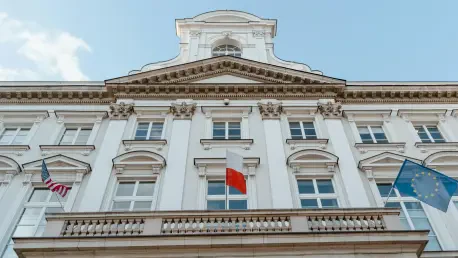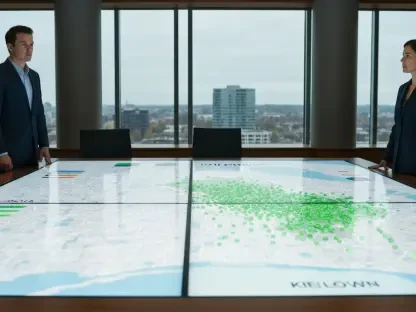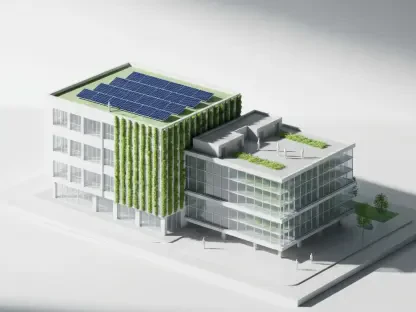In a remarkable blend of cross-continental collaboration, an Australian-German team has captured the spotlight by securing the top prize in the first phase of a highly competitive design contest. This competition, organized by the German government, was aimed at reimagining the German Embassy in Canberra. The winning team is composed of Berlin-based Richter Musikowski and Sydney’s Lahznimmo Architects, along with Spackman Mossop Michaels Landscape Architects. This victory signifies a harmonious merger of architectural ingenuity and environmental stewardship.
Harmonizing Architecture with Nature
A Unique Design Vision
The winning concept presents an innovative approach that marries the historic and natural elements of Canberra with modern architectural principles. Key to this successful design is the introduction of a new three-story chancellery and a strategic expansion of an existing residence. This redesign respects the traditional urban aesthetics while enhancing views of the majestic Black Mountain. The site’s natural harmony has been carefully preserved as the design effortlessly merges with Canberra’s environmental backdrop. The structures are artistically linked by a pergola roof, creating a distinctive garden area symbolizing the close relationship between Germany and Australia, highlighting shared values such as democracy and inclusion.
Furthermore, the landscape development, driven by Spackman Mossop Michaels, reflects a deep commitment to environmental conservation. By drawing inspiration from the Monaro Grasslands, the design incorporates native flora, including the resilient snow gum eucalyptus. This choice enhances the region’s biodiversity and aids in the propagation of seeds from endangered species, effectively shifting from a high-maintenance landscape to one that is drought-resistant and sustainable. This ecological approach not only beautifies the space but also promotes a sustainable and forward-thinking vision for embassy landscapes.
Integrating Functionality with Sustainability
Architectural functionality is creatively woven into the embassy’s environment, introducing a “shady garden” aesthetic that enriches the experience of space within the embassy grounds. This is achieved through the implementation of structured soffits and strategically placed light openings, which foster versatile meeting areas. The design includes shaded terraces on the chancellery roof and covered outdoor spaces to facilitate social interactions. Sustainability is a core pillar of the design, aligning with the German government’s ambitious net-zero emissions target by 2045. The project aspires to achieve a 6-star Green Star rating, reinforcing its commitment to environmental responsibility.
Embracing “low-tech” features, the design uses locally sourced materials, such as recycled bricks for terrace surfaces and recycled concrete for pathways. Innovations like advanced rainwater harvesting systems contribute to efficient water management. This holistic approach ensures that the architectural and environmental aspirations of the project coalesce into a sustainable and socially engaging space, setting a precedent for future embassy projects worldwide.
Cultural and Collaborative Synergy
Celebrating Cross-Continental Collaboration
The success of the Australian-German team underscores the promising results that arise from effective international collaboration. Following the first prize awarded to the Richter Musikowski and Lahznimmo Architects-led team, another Australian-German ensemble, consisting of Buero Hacke from Berlin and Kerstin Thompson Architects from Melbourne, secured second place. These achievements highlight a growing trend of fruitful partnerships between Australian and German firms, merging diverse architectural philosophies to yield innovative and responsive design solutions.
Both the first and second prize winners are propelled to advance to the subsequent phases of the competition, further illustrating their commitment to harmonizing architectural elegance with sustainable and symbolic attributes. Their combined efforts reflect a forward-thinking benchmark for embassy design that integrates cultural symbolism with environmental consciousness. This progressive journey redefines how embassies can serve as cultural landscapes that embody shared values and ecological responsibility.
A Blueprint for Future Designs
The cooperative success of these international architectural teams offers insightful lessons for future projects, particularly in the realm of global diplomacy and sustainability. By seamlessly integrating environmental features into their designs, these architects not only respond to the immediate requirements of the competition but also address broader global environmental concerns. Their designs serve as exemplary models for how diplomatic spaces can be both functional and symbolic, reflecting the harmonious relationships between nations.
As these projects move forward, they hold the potential to set new standards in international architecture, emphasizing the value of cross-cultural collaboration paired with a commitment to sustainable design principles. The case of the German Embassy in Canberra stands as an inspiring milestone, showcasing the potential of global partnerships to achieve excellence in architectural design that respects both cultural heritage and environmental sustainability.
Paving the Path for Future Diplomatic Architecture
A fascinating example of international collaboration has emerged with an Australian-German team capturing the limelight by winning the prestigious first phase of a challenging design competition. This event, organized by the government of Germany, sought visionary proposals for reimagining the German Embassy located in Canberra. The triumphant team consists of Berlin-based Richter Musikowski alongside Sydney’s Lahznimmo Architects, and they are joined by Spackman Mossop Michaels Landscape Architects, illustrating a dynamic cross-continental partnership. Their achievement symbolizes not only an impressive blend of architectural creativity but also a strong commitment to environmental responsibility. This victory highlights the seamless integration of innovative design techniques and sustainable practices in architecture. It also sets a new benchmark for future collaborations between countries that stress the importance of artistic vision paired with ecological mindfulness, making the fruition of this project a source of inspiration for international design communities.









